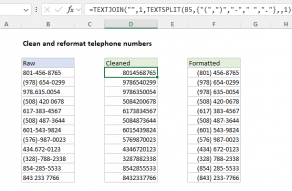Explanation
The TRIM function is fully automatic. It removes both leading and trailing spaces from text strings, and also "normalizes" multiple spaces between words to one space character only. All you need to do is supply a reference to a cell.
TRIM with CLEAN
If you also need to remove line breaks from cells, you can add the CLEAN function like so:
=TRIM(CLEAN(text))
The CLEAN function removes a range of non-printing characters, including line breaks, and returns "cleaned" text. The TRIM function then takes over to remove extra spaces and returns the final text.
Other problematic characters
Note that CLEAN cannot remove all non-printing characters, notably a non-breaking space, which can appear in Excel as CHAR(160). By adding the SUBSTITUTE function to the formula, you can remove specific characters. For example, to remove a non-breaking space, you can use:
=TRIM(CLEAN(SUBSTITUTE(B1,CHAR(160)," ")))













